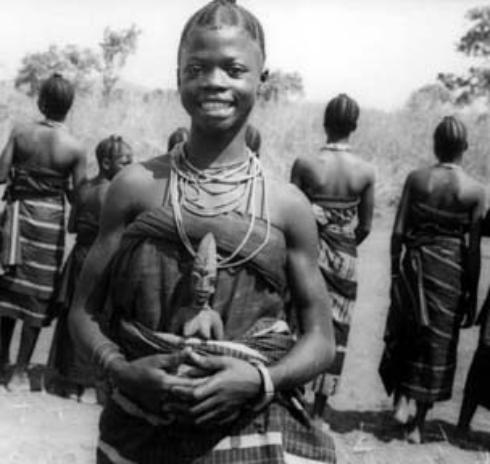 |
An interesting Ere Ibeji couple, standing on oval bases, the arms touch the thighs, the male figure wears a helmet, the female wears her hair helmet-like in the middle quasi erect. Hair and helmet are blackened. The facial expression of both is gravely on guard but most visible in the woman. Her ears are big and round. The scarifications of both reach from the hairline to the mouth in an L-shape and there are three more on each of the cheeks. The noses are flat, the bulging eyes are big and round. Both figures wear beads around neck and waist;
Shiny, blackened to brownish patina. The colour of the helmet is rubbed off on two little spots on the lower ends on the back side. Besides that excellent condition.
The Yoruba of Nigeria and of the Benin Republic are known for having an extraordinarily high rate of multiple births. The rate of twin births is one of the highest in the world, 45 of every 1,000 births (in the United States it is 28.9 of every 1000). There is also a high mortality rate; half of the twins die shortly after birth. In earlier times, new-born twins, or ibeji, as they are called, were believed to be evil, monstrous abnormalities and infanticide was a common practice. However, such beliefs and practices were later superseded and reversed, and by the middle of the 18th century twins came to be seen as a blessing; theywere awarded the status of minor deities, called Orishas, and their arrival was viewed as an omen of good fortune for the family. By the 19th century the cult of the Ere Ibeji was firmly established and continues to this day. The death of one or both twins is regarded as a great calamity for the family, one which requires immediate appeasement of the soul of the deceased child. The first born twin, whether a boy or a girl, is always called Taiwo, meaning ‘having the first taste of the world’, whereas the second is named Kehinde, meaning ‘arriving after the other’. Although being born first Taiwo is considered as the younger twin. His senior Kehinde is supposed to send out his partner to see what the outside world looks like. As soon as Taiwo has given a signal by crying, Kehinde will follow. Kehinde is supposed to be more careful, more intelligent and more reflective, while Taiwo is believed to be more curious and adventurous, but also more nonchalant.
(Olaleye-Oruene, 1983; Stoll & Stoll, 1980).
Literature: Yoruba Customs and Beliefs Pertaining to Twins. Fernand Leroy, Taiwo Olaleye-Oruene, Gesina Koeppen-Schomerus and Elizabeth Bryan, Cambridge University Press, Volume 5, Issue 2 , 01 April 2002, p. 132ff. Ibeji Custom in Yorubaland. Timothy Mobolade, Volume 4, Issue 3, 1971.

From the book, Ibleji. The cult of Yoruba twins, George Chemeche, 2006.“ Fotos by William Fagg and Deborah Stokes, 1980.
sold Height: 32 cm / 31 cm
Weight: 290 g / 260 g |
 photo: tribalartforum.com/ identification no. BSC04225.jpg
photo: tribalartforum.com/ identification no. BSC04225.jpg |
|